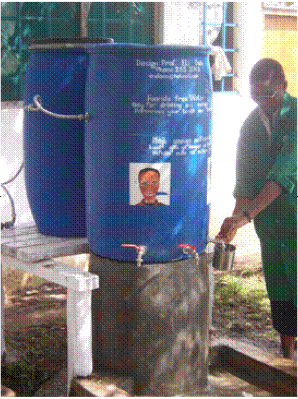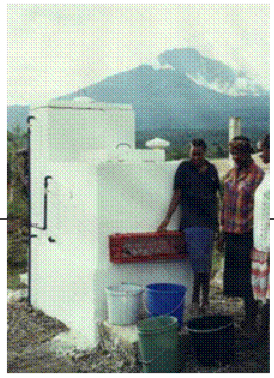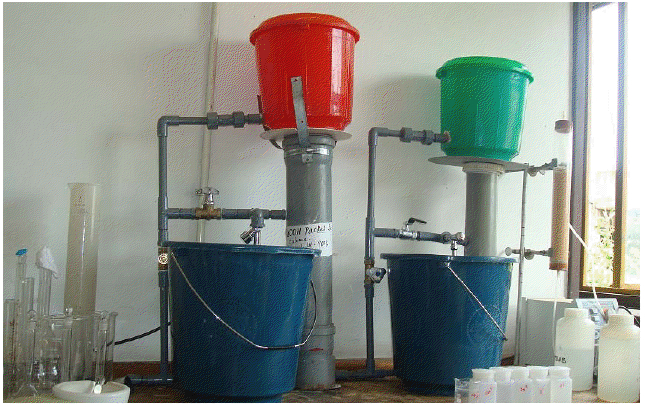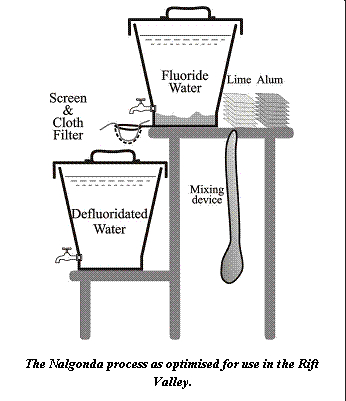Difference between revisions of "De-fluoridation"
m |
|||
| Line 17: | Line 17: | ||
The most common defluoridation methods used in developing countries at present are sorption on activated alumina, co-precipitation with aluminium hydroxide (known as the Nalgonda Technique) and sorption on bone char. | The most common defluoridation methods used in developing countries at present are sorption on activated alumina, co-precipitation with aluminium hydroxide (known as the Nalgonda Technique) and sorption on bone char. | ||
| − | [[File:fluoride absorbers.jpg|thumb|center|400px|Materials that absorb fluoride. Chart:[http://www.de-fluoride.net/defluoridation. | + | [[File:fluoride absorbers.jpg|thumb|center|400px|Materials that absorb fluoride. Chart:[http://www.de-fluoride.net/defluoridation.html De-fluoride.net.]]] |
==Field experiences== | ==Field experiences== | ||
Revision as of 19:01, 23 May 2012


Photo: De-fluoride.net.
High levels of fluoride in groundwater has been reported parts of in Ethiopia, Malawi, Kenya and Tanzania and can lead to health problems including dental fluorosis, osteosclerosis, thyroid problems, growth retardation and even kidney failure. WHO report shows excessive fluoride intake (3-6 mg/L) can lead to severe and permanent bone and joint deformations of skeletal fluorosis and the consumption of drinking water with even higher fluoride concentrations (10 mg/L) can lead to crippling fluorosis, which causes the hardening and calcifying of the bones.
Most of the methods currently available for the removal of fluoride from drinking water are either too expensive, are technically unfeasible for household use or change the water quality. The removal of fluoride from water using aluminium hydroxide has been investigated and a household defluoridation unit (HDU) has been designed and tested.
Contents
Suitable conditions
Treatment at household level has several advantages over treatment at community level. Costs are lower, as defluoridation can be restricted to the demand for cooking and drinking which is usually less than the total water demand and make people a sense of ownership. This treatment option may be feasible in less developed countries especially in rural areas, where settlements are scattered.
Treatment of fluoride contaminated water at the source is carried out on a large scale under the supervision of skilled personnel, without direct involvement of the users, and where the affordability of treatment is taken for granted. In such cases the method of treatment is well established and well controlled. However, it requires major input of resources and may have serious limitations or disadvantages in less-developed countries; especially in rural areas where the settlements are scattered. This is especially adopted in developed countries.
Construction, operations and maintenance
There are several methods which have been developed to reduce fluoride from contaminated water, such as adsorption, ion exchange, precipitation, electrodialysis and reverse osmosis. These methods have rarely been implemented in developing countries, except in some areas, due to insufficient removal efficiency, unaffordable costs, complicated operation and maintenance, particularly for rural populations.
The most common defluoridation methods used in developing countries at present are sorption on activated alumina, co-precipitation with aluminium hydroxide (known as the Nalgonda Technique) and sorption on bone char.

Field experiences
In the Rift Valley regions of Ethiopia where there is a high fluoride concentration, the settlement of the people in the rural areas is scattered. Therefore to combat the problem of fluorosis household treatment system is a reasonable approach. Thus it is necessary to develop a household scale defluoridation unit that can be applicable in these areas.
Reference manuals, videos, and links
- Groundwater fluoride levels in villages of Southern Malawi and removal studies using bauxite. International Journal of Physical Sciences Vol. 3 (1), pp. 001-011, January, 2008.
- Defluoridation of water by a one step modification of the Nalgonda technique. Annals of Tropical Medicine and Public Health.
Acknowledgements
- WONDIMAGEGN, AGEGNEHU ALEMU. DEVELOPMENT OF HOUSEHOLD DEFLUORIDATION UNIT BASED ON ALUMINIUM OXIDE HYDROXIDE. December, 2008.
- Dahi, Eli. Defluoridation. March, 2009.


